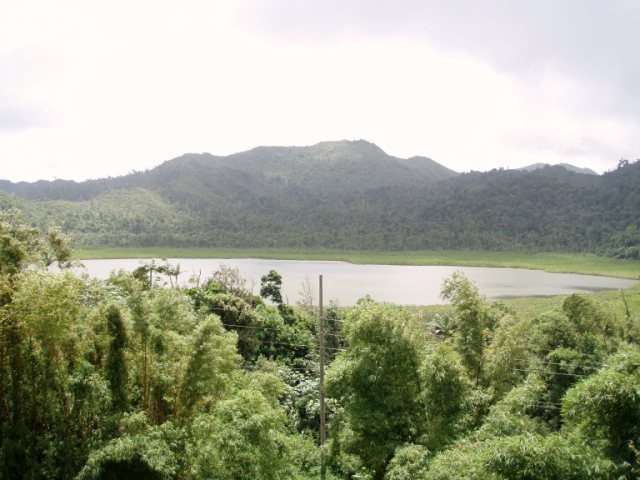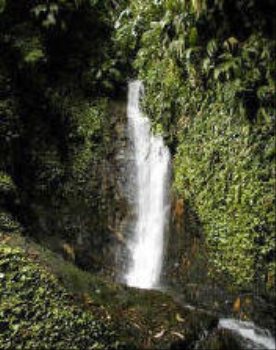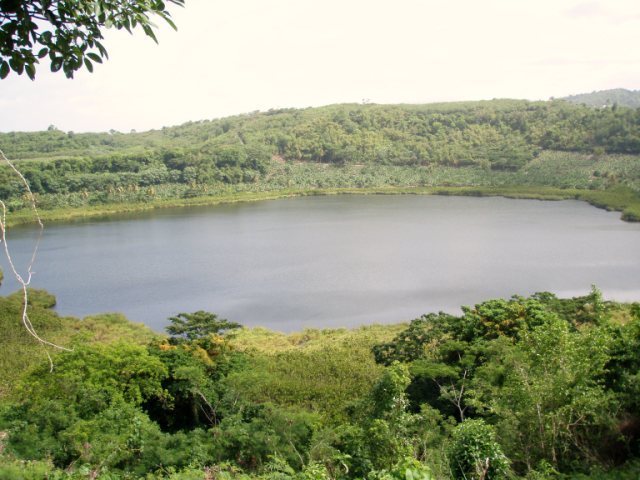Day 3 - Grand Etang

|
Grand Etang Lake and Forest Reserve  We started the day
at the Interpretation Centre at Grand Etang. We had been told to take a bag of
fruit and lay it out on the fence and a troop of Mona Monkeys would come to
feast. We had also been told that if we looked as though we were going to steal
the fruit they would give us a good slap. Looking forward to this I asked my
Captain to do his "Monkey Whispering" as he had been so successful with the
tortoises in Guadeloupe, but despite his "Wooooooooooo
Woooooooooooooooaaaaing" nothing happened. I
think they are deaf and I had no help whatsoever from my compatriot.
So we went to sit by Lake Etang for a
picnic.

  Grand Etang Lake,
The picnic supervisor and our little hire car.
The most popular area in Grenada for hiking and trekking
is undoubtedly the rainforest around the Grand Etang Forest Reserve, high up in
the mountains of the island's interior. Grand Etang's varied elevations and
terrains maintain several different ecological subsystems, culminating in the
elfin woodlands high up the slopes of the reserve's central mountains. The focal
point of the forest reserve is Grand Etang Lake, which fills the crater of one
of the island's extinct volcanoes. The rainforest around the lake holds a
stupendously rich diversity of flora and fauna. Colourful tropical birds, tiny
frogs and lizards, and rare orchids punctuate the dense rainforest vegetation,
and the trails meander around the area's stunning waterfalls as well as the
azure waters of Grand Etang Lake. Grand Etang's flora
includes towering mahogany and giant gommier trees as well as a multitude of
ferns, tropical flowers, and other indigenous plants. The lush vegetation
provides shelter for a wide variety of animals, particularly for the island's
many species of birds. The broad-winged hawk (known here as the gree-gree),
Lesser Antillean swift, Antillean euphonia, purple-throated carib, Antillean
crested hummingbird (known as the little doctor bird), and the Lesser Antillean
tanager (known as the soursop) are all common sights. In addition, the Grand
Etang is populated by plenty of frogs and lizards, as well as playing host to
opossums, armadillos, mongooses, and the mona
monkey. Hikes at Grand Etang range from easy 15-minute jaunts to rigorous expeditions of several hours. The trails are quite good, and the Forest Reserve provides excellent guides (both written and human). The reserve's hikes include:
Honeymoon Falls
The Morne LaBaye Trail The Ridge and Lake Circle Trail Mt. Qua Qua Trail
Lower two of the Seven Sisters
Seven Sisters Trail
Fedon's Mountain & Concord Falls Branching off from the
Concord Falls Trail before it reaches the cascades is the short but demanding
path leading up to the cave-like recess of Fedon's Camp. The camp was the
strategic base of Julien Fedon, a Grenadian of French origins who led a slave
uprising against the British in 1765. This well-maintained but arduous trail
takes you deep into the very heart of the Grand Etang rainforest, through shady
groves mahogany, teak, and many of Grenada's other tree species. Giant ferns and
birdlife abound here, including the green-throated carib and the yellow-billed
cuckoo. A guide is recommended for both the Fedon's Mountain and the Concord Falls treks.
Levera National Park
Lake Antoine National Landmark
This shallow crater lake, like Grand Etang, is host to a wide variety of wildlife. The lake's perimeter trail, a beautiful walk in itself, is another of Grenada's excellent attractions for birdwatchers. Among the species frequently sighted are the snail kite, the fulvous whistling-duck, large-billed seed-finch, gray kingbird and limpkin. ALL IN ALL WE ARE AWED
AT THE BEAUTY WE HAVE FOUND HERE IN
GRENADA
|




